Growth Newsletter #286
For startups and small businesses, there seems to be a deep chasm between two schools of “brand” thought: one that’s entirely too small-minded and another that’s way too big-picture to feel applicable.
What I mean by this is, “branding” is either shorthand for a logo and maybe some colors. Or it becomes some far-off, completely useless anecdote about larger-than-life legends like Nike, Apple, or Liquid Death.
But I’ve spent the last ten years working on brands of pretty much every size and industry (skewing more toward SMBs than enterprise-level companies) and the tenets of a strong brand identity remain largely the same. Only the budgets and brand awareness levels change.
But startups need particularly sharp, well-defined brand identities, maybe even more than bigger companies do.
Because if you’re entering a saturated market, competing against more established names, or selling something that’s niche or nuanced, you need serious discipline to build a brand that helps you grow.
Without a solid understanding of what you are (and especially what you aren’t), it’s easy to fall victim to shiny-object syndrome and give prospects whiplash from continual language pivots and visual inconsistencies.
So today’s newsletter will take an abridged look at the basics of brand identity, especially as they relate to startups. For more depth and detail, there’s plenty to sink your teeth into in the Growth Program 2.0.
It’s my hope that this newsletter can share useful insights that “bridge the gap” between “Brand identity is a logo” and another Liquid Death think piece, especially for startups in those early, soul-searching stages.
— Gil
This week's tactics
Four Forces Behind a Strong Brand Identity
Insight from Gil Templeton — Demand Curve Staff Writer
Before we get into the nitty-gritty, let’s talk about why brand building is so much easier said than done. And why everyone can point at the greats and say “Yeah, just do that!” But very few can actually do it when push comes to shove.
It starts with nailing your product, of course. Then it’s about making sure your mission statement, story, voice, and design are all rowing together to build confidence in consumers’ minds. More on those in a bit.
“The personality of a product [or brand] is an amalgam of many things — its name, its packaging, its price, the style of its advertising, and above all, the nature of the product itself.” — David Ogilvy, Iconic Ad Man
While the essence of this quote is accurate, David Ogilvy was living in far simpler times back in the 60s and 70s.
He’d surely short-circuit if he saw brand teams A/B testing TikTok hooks for three-second attention spans or if he saw a growth team debating whether their mascot needed its own LinkedIn profile. But these reflect the everyday questions asked of modern brands.
The hard part is continually ushering your brand through a thousand different needs and asks, protecting its integrity and even sharpening its essence along the way.
The best way to stay the course through these constant challenges and questions is by aligning on a few rock-solid cornerstones of your brand identity.
Let’s talk about building that solid foundation (that will still need plenty of protecting and shepherding along the way).
1. Mission Statement
This is your North Star. It’s a short description (one bold and audacious sentence, often starting with the word “to”) that lays out your big-picture, perfect-world goal. It can serve both an internal and external purpose.
- Internally, it guides strategic decisions about your product, business model, ideal audience, and acquisition channels, and even the people you hire or partner with.
- Externally, it communicates what your company cares about, in order to better relate to customers. (But it’s not mandatory to make it public-facing).
Below are a few examples of well-known companies’ missions:
- Slack: To make work life simpler, more pleasant, and more productive.
- Tesla: To accelerate the world’s transition to sustainable energy.
- OpenAI: To ensure that artificial general intelligence benefits all of humanity.
- Stripe: To increase the GDP of the internet.
- Shopify: To make commerce better for everyone.
Notice how these are massive, daring missions, evocative of a BHAG (or a Big Hairy Audacious Goal). Slack doesn’t talk about making the best work messaging app. Nor does Tesla say a word about cars.
This is because your mission statement should be an incredibly high-level statement, no need to stoop down to the mere products or services you offer.
The bigger and less attainable it seems, the better.
💡 Exercise: Use this prompt to craft your mission statement:
- If we completely succeed at what we’re building, how will the world (or our industry) look different because of it?
2. Brand Story
Think of your brand story as a more detailed expansion of your mission statement. It’s a narrative about how your company came to be and why it does what it does.
The most effective brand stories stir emotion. As humans, we’re drawn to stories because they engage and inspire us. They help us process information in a much more memorable way than simply reading a list of statistics.
Remember, without tension or conflict, there is no story. So make sure this “enemy” or problem is turned up in the mix.
There tend to be two common approaches for framing a brand story:
- Origin: This approach focuses on how a company came to be and the people behind it. It’s best for those with interesting or unusual backgrounds. For instance, a broke dumpster diver named Sophia Amoruso opened an eBay store for her vintage finds, which eventually became the Nasty Gal fashion brand.
- Consumer-focused: This approach places customers at the center of the brand story, describing how they needed a solution to make something possible or make something go away. These stories work best for companies that have more straightforward origins, e.g., you saw an unmet need and created a product to address it.
Neither approach is better than the other; they’re just different storytelling methods. That said, both approaches should tie your company’s success to the customer in a direct way.
Here’s an example of an origin story from the eco-friendly toilet paper company Who Gives A Crap:
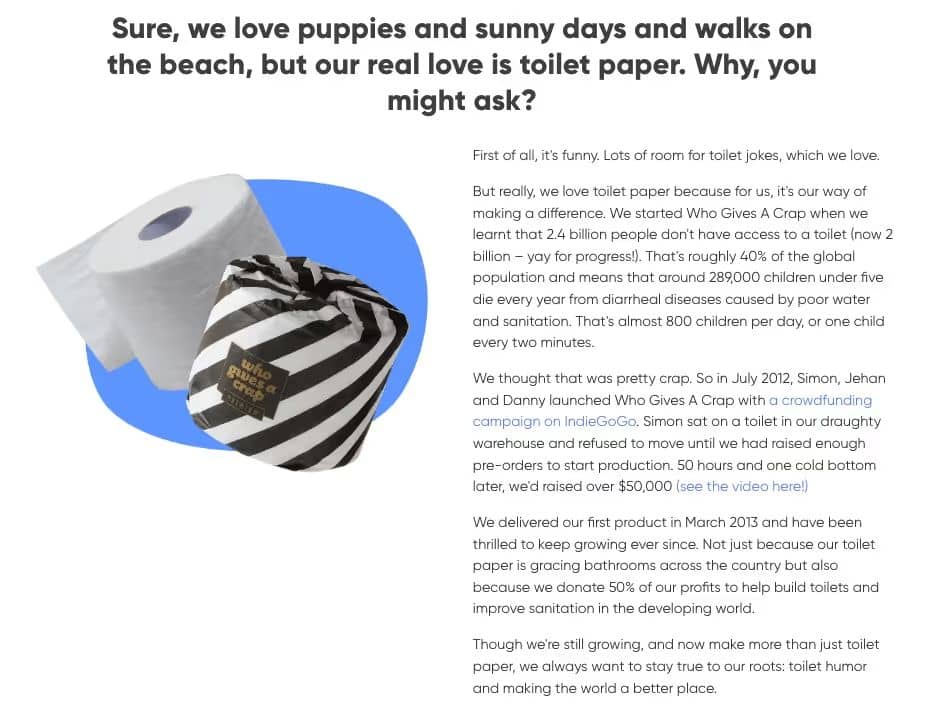
Using the origin approach outlined above, Who Gives A Crap tells the story of how its founders were appalled to learn about poor sanitation around the world, which led them to create a crowdfunding campaign.
The story then addresses its customers by noting how the company’s supporters have helped build toilets and improve sanitation in the developing world. So despite initially focusing on its founders, Who Gives A Crap’s story positions customers as a key to its success.
Companies that don’t have an emotionally compelling history might struggle to create an origin story that feels authentic. In that case, it’s better to write your brand story using a consumer-focused approach.
Here’s an example from BIC, the maker of ballpoint pens, lighters, razors, etc.
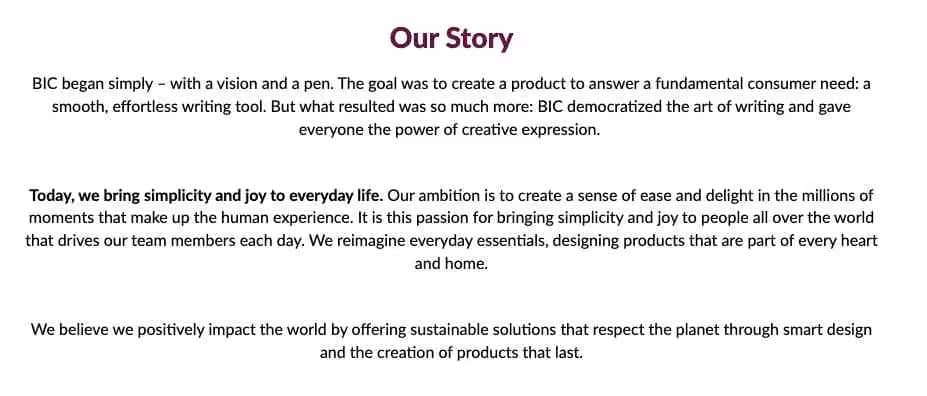
Notice how BIC describes itself as giving consumers “the power of creative expression.” The story revolves around BIC’s goal to “answer a fundamental consumer need” rather than details about its founders. It’s inspiring yet grounded.
Regardless of how your company got started, your brand story shouldn’t be an advertorial to help get your product onto more shelves. Give it some emotional weight, so it can resonate more deeply with your audience.
Your brand story doesn’t need to be long. Who Gives A Crap’s is 235 words; BIC’s is 140. Aim for under 250 words. Keep it simple.
💡 Exercise: Consider these following questions when brainstorming or writing your brand story:
- How was your product inspired by a very real need or desire?
- What value does your product provide to people who buy it or use it?
- Why should customers choose you over a direct competitor?
3. Brand Voice
Your brand voice is how your company would sound if it were a person. It comes across in all your company’s communications. And I mean ALL of them.
A single adjective like “casual” isn’t enough. You should specify more details around your brand’s tone of voice and the vocabulary it uses.
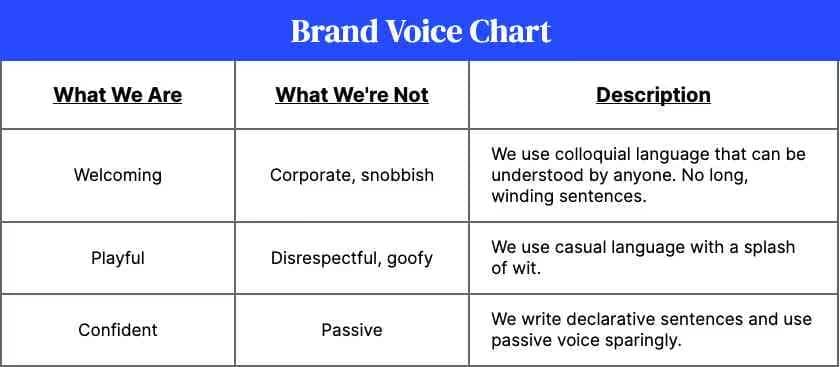
Try creating a brand voice chart to narrow down what your brand sounds like. Here’s one we’ve created for a fictional company. Use it as a template for yours.
Three key DOs and DON’Ts are a good number. When you start getting into four or five tenets of your brand voice, things can either feel nebulous or like a really tight needle to thread.
(Hey, does this headline sound warm, empathetic, hopeful, grounded, and confident?)
Oh, and don’t fall into the common trap of using “authentic” as a key tenet of your brand voice. In my opinion, it’s a throwaway descriptor that doesn’t provide helpful guidance. QUICK: name a couple brands that have an “authentic” tone. Yeah, I thought so.
It also gives everyone on the team license to use their “authentic” tone which can get wily, fast.
Choosing your brand archetype can help define your role with the customer and influence your voice. Choose from this set of twelve well-defined, agreed-upon personalities below, which do a good job at encompassing pretty much every angle a brand can take.
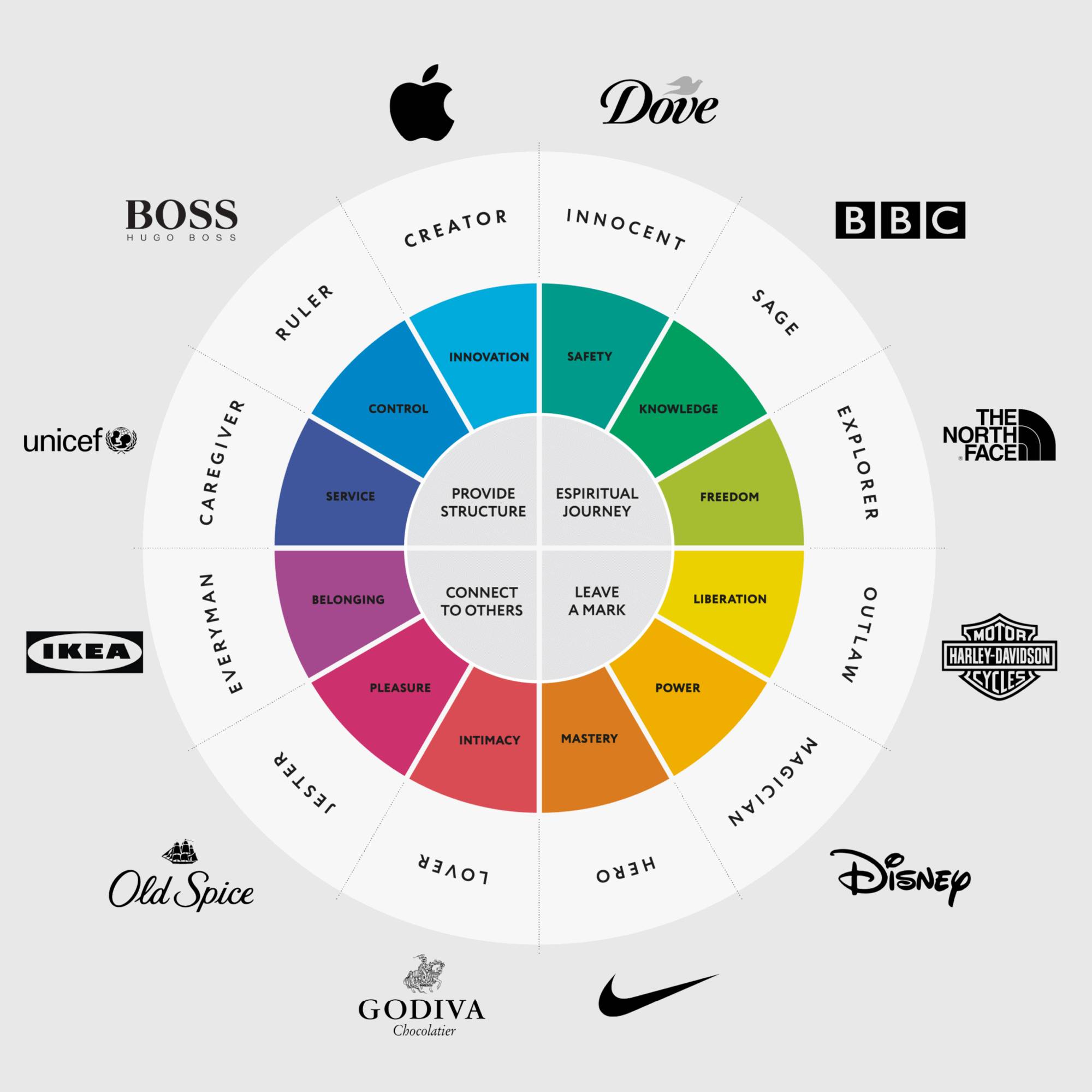
One thing I like to explore when it comes to brand voice is finding the right “brand muse” that embodies our spirit. Got a manly beef jerky brand? Maybe your muse is Ron Swanson. Got an app that’s snarky and disruptive? Your muse might be Deadpool.
Putting a face to this exercise can really help teams grasp the tone. You can hold your messaging up against your muse as a litmus test and ask, “Is this something [our muse] would say or not?” This can be incredibly helpful in giving your team guidance.
4. Brand Design Basics
I’m not going to act like I can cover all of brand design in 1/4 of a newsletter, so this section is here to give you background on the design needs your brand might have right out of the gate.
Brand design revolves around the visual elements that represent your company. It should be as memorable and distinct within your category as possible.
Here are some of the most important, common components of your brand design (if you want to reference them for a project scope with a designer or art director):
- A unique and recognizable logo design
- A defined color palette with 2–4 colors
- 2-3 complementary typefaces
- Company iconography (these are the graphic symbols that represent specific actions, like a shopping cart, messaging bubble, favicon, packaging callout, etc.)
- Guidance on and examples of imagery, photography, and other elements like textures
- A website that combines all of the above assets in a cohesive manner
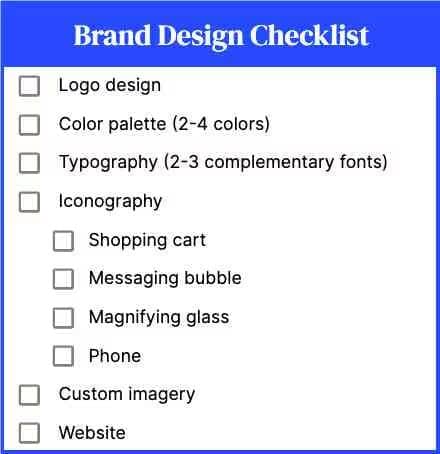
Compared to the other branding components we’ve highlighted, this part might be where things get a little expensive. That’s because strong brand design requires a high level of craft and creativity.
And that can get expensive (tens of thousands of dollars & up) if you go with a high-end agency or design shop.
So if your company is in its nascent stages, we recommend working on your mission statement, story, and brand voice yourself and spending no more than $10,000 on brand design.
If you’re on a super tight budget, use 99designs, Upwork, or Fiverr and focus on a logo, brand colors, typography, and iconography. These platforms will not give you the best assets in all likelihood, but they at least offer a “minimum viable brand,” and you can invest more once you can afford it.
Once you’ve proven viability or received your first round of funding, that might be a good time to level up and ensure your design is airtight and professional.
Gil Templeton
Demand Curve Staff Writer
Community Spotlight
News and Links
Something fun
Something fun
A scathing letter from the founder of Lululemon, who isn’t happy with the state of the brand today. He’s so mad, he bought a full page in the Wall Street Journal to give them a piece of his mind. Yikes.
.png)




















